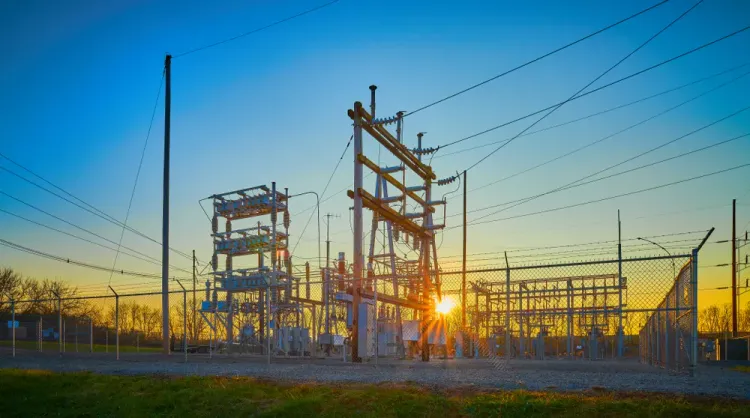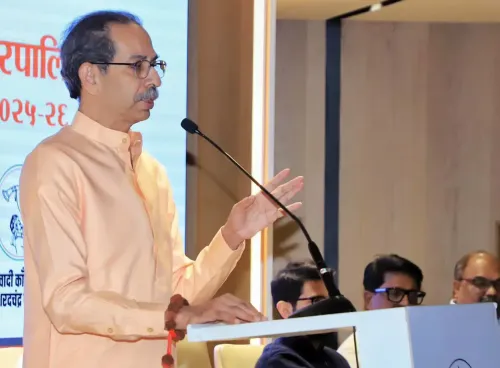India's Electricity Demand Peaks in March Due to Rising Temperatures and Industrial Growth

Synopsis
Key Takeaways
- Power demand rose by 6.9% in March.
- Peak demand reached 235 GW.
- Power generation jumped 8% year-on-year.
- Coal-based generation was 75% of total output.
- Renewable energy share increased to 14%.
New Delhi, April 10 (NationPress) The electricity demand in India saw a significant increase in March as temperatures climbed and the requirements from industrial and commercial sectors surged, as detailed in a report by Crisil Intelligence released on Thursday.
The average monthly temperature reached 25.5 degrees Celsius, surpassing the 30-year average of 24.71 degrees Celsius (1991-2020).
Regions in western and eastern central India experienced between 1 to 5 heatwave days throughout the month. Consequently, power demand escalated by 6.9 percent, significantly exceeding the annual average increase of 4.3 percent. In western India, demand surged by 10 percent compared to the previous year, particularly in Gujarat, which faced six days of heatwaves.
The report indicates that the seasonally adjusted India PMI, a measure to gauge the nation's industrial activity, improved from 56.3 in February to 58.1 in March, marking the highest figure in eight months. This latest data reflects a notable enhancement in the manufacturing sector's health, exceeding its long-term average.
With approximately half of India's electricity demand coming from industrial and commercial users, the expansion of these activities is essential for sustained power demand growth, the report emphasizes.
Increased cooling needs drove peak power demand to 235 GW, an increase of 14 GW from the last fiscal year. This surge also impacted the short-term power market.
The real-time market (RTM) volume climbed by 34 percent year-on-year to 3,727 million units (MU). The RTM's share of total electricity volume traded on the IEX reached 33 percent, compared to an average of 24 percent since its establishment in June 2020 through March 2025. Despite the volume increase, the average market-clearing price for March 2025 remained stable at Rs 3.93/unit, slightly up from Rs 3.91/unit, due to a rise in power supply.
Power generation increased by 8 percent year-on-year to 161 billion units (BU) in March, aligning with the power demand. However, when compared to February, the growth rate was even higher at 13 percent.
All fuel types reported growth of over 5 percent in March. Coal-based power generation rose by 6.7 percent this March, building on a high base of 9.4 percent the previous March, totaling 120 BU. Coal accounted for 75 percent of the total power output, underscoring India’s ongoing dependence on coal during periods of heightened demand.
Renewable energy (RE) generation also increased, growing by 15.4 percent year-on-year on a strong base of 11.4 percent from the last fiscal year. The share of RE in the fuel mix for the month rose to 14 percent, up from 12.7 percent in March 2024, reflecting the country’s endeavors to meet its COP26 commitments.
Hydro and nuclear energy production increased by 33 percent and 17 percent year-on-year, contributing 6 percent and 3 percent to the total, respectively.
Coal dispatches—India's main fuel for power generation—rose by 6.25 percent in March and 6 percent year-on-year in fiscal 2025, leading to improved inventories.
As of March 31, thermal power plants had 58 million tonnes (MT) of coal stock, compared to 51 MT a year earlier. Coal inventory improved to 20 days as of March 31, compared to 18 days in March 2024 and 19 days in February 2025.
Overall, power demand increased by 4.3 percent year-on-year in fiscal 2025 to 1,695, following three consecutive years of high growth with a CAGR of 7.1 percent between fiscals 2022 and 2024.
For the first quarter (April-June) of fiscal 2026, Crisil Intelligence anticipates power demand to rise between 6.5-7.5 percent compared to the same period last year, down from 11 percent in the prior fiscal. With the India Meteorological Department predicting over a 50 percent chance of above-normal temperatures during the summer months of April, May, and June, cooling requirements are expected to rise.










